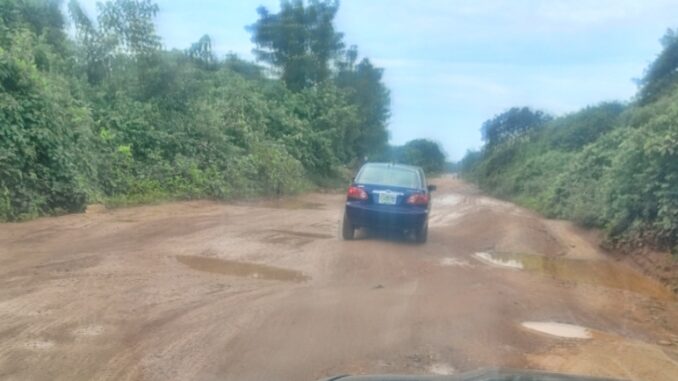By Boluwatife Adedokun
Twenty days after the Osun State Government announced “spot rehabilitation” would commence on the Osogbo–Iwo road ahead of full reconstruction, a drive-through by The Harbinger on Wednesday found no active repair crews or fresh works along major failed sections of the corridor.
The carriageway remains cratered in multiple stretches, with standing water and edge breaks forcing motorists to weave dangerously into opposing lanes.
On 3 August 2025, Governor Ademola Adeleke, through his spokesperson Olawale Rasheed, ordered emergency spot fixes on the Osogbo–Iwo road and said the directive would be implemented “with commencement date next Tuesday,” pending the full reconstruction promised by the administration. The statement also referenced the “twilight award” of the same project by the previous government and alleged inherited contractual complications.
Promises vs. Reality on the Ground
In line with that August 3 directive, road users expected to see cold asphalt patching, grading, or at minimum traffic control measures along the worst-failed segments within days.
As of The Harbinger’s field check yesterday, however, there were no visible signs of fresh palliative work along the sections traversed. We observed long-standing pothole clusters, silted drains and shoulder failures that continue to threaten vehicle suspensions and road safety. (This assessment reflects The Harbinger’s direct observation; it is not a full engineering audit.)
This is not the first time the corridor has attracted official attention. The wider Ibadan–Iwo–Osogbo axis has been repeatedly flagged by commuters and media for its deplorable condition over the years, underscoring how chronic the maintenance backlog has become across the link between Osun’s capital and its north-western belt.

What the Government Said Would Happen
In the August 3 press release, the government framed the new palliatives as a bridge to an eventual full reconstruction, while blaming legacy contractual issues for the delay in comprehensive works. It promised “spot rehabilitation” would commence the following week, and it tasked the Ministry of Works to “draw a work plan and commence implementation.” For accountability, the statement also referenced concerns from Iwo stakeholders and diaspora groups, positioning the palliatives as a confidence-building step.
Budget Reality Check: Where Is the Money?
Osun State’s 2025 Draft Estimates set Total Capital Expenditure at ₦98.77 billion, with the Economic Sector (which typically houses Works/Transport) carrying Total Expenditure of ₦127.82 billion, split between Personnel (₦9.67 bn), Overhead (₦8.51 bn), Social Contributions/Benefits (₦136.7 m), and Capital (₦109.50 bn). These are sizable headline figures that, on paper, could accommodate meaningful roadworks if prioritized and cash-backed.
However, the publicly accessible budget summary pages do not disaggregate capital projects by specific road corridors in a way that allows citizens to track how much—if any—of the 2025 capital envelope is ring-fenced for the Osogbo–Iwo road. Without line-item disclosures and a procurement trail (advertisements, bid awards, mobilization certificates), it is difficult for the public to verify timelines or reasons for slippage on particular corridors.
Concentration of Big-Ticket Projects in Major Urban Centers
The state has actively flagged off marquee projects in major towns, including a ₦14.9 billion flyover at Lagere, Ile-Ife, launched in May 2024. That project has been publicly profiled and justified as part of the administration’s push to upgrade strategic urban nodes.
Against that backdrop, commuters on the Osogbo–Iwo corridor question why their own lifeline continues to deteriorate despite repeated assurances. The government’s August 3 statement sought to address exactly that concern, promising quick palliatives ahead of a full rebuild—yet no early-stage activity was apparent during The Harbinger’s drive-through yesterday.
Why the Delay Matters
The Osogbo–Iwo road is a primary economic artery for farm produce, livestock movement, inter-city commuting, and access to health and education services in the state’s north-west. Prolonged neglect increases vehicle operating costs, heightens accident risk, and erodes productivity—costs ultimately borne by households and small businesses.
Moreover, when official timelines slip without public explanation, it undermines trust in government communication. In this case, the administration set a near-term expectation (“next Tuesday”) and linked it to a road with long-documented failures. The absence of visible progress weeks later risks deepening public cynicism—especially because many residents already perceive big-ticket capital projects as being concentrated in a few large towns, even as arterial roads elsewhere remain in distress.




